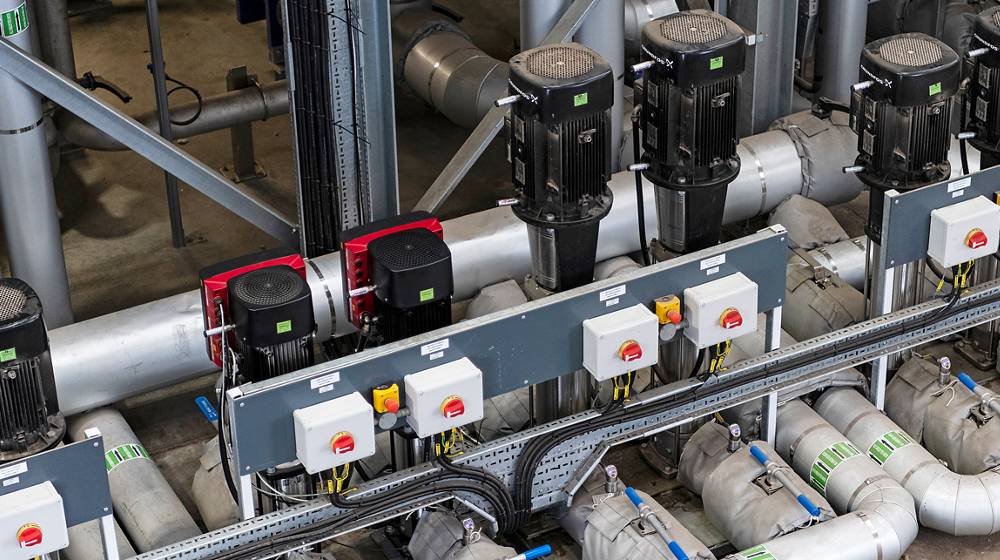Case Study
Grundfos Pumps Ltd
The situation
Commercial whisky production relies heavily on steam. That is no exception at William Grant & Sons’ Girvan Distillery in Scotland, which produces more than 100 million litres of alcohol a year.
“We use steam for all aspects of cooking the wheat,” explains Scott Curran, maintenance team leader. Every week, Grant’s mills and cooks 5,000 tonnes of grain in different ways, depending on the brewing process. Grant’s uses steam to preheat all the water, he explains, and it also uses direct injection steam for part of the cooking process. When the cooked malt or grain reaches the distillation columns, it needs to be heated again to remove the vapours that contain the alcohol.
“So a lot of steam generation is needed for this process,” Scott Curran says. “Very, very high demand.
”Previously, Grant’s was having a problem with its steam quality. “It’s a big issue. With most sites, the better the steam quality, the less water retention within the steam.” So with high-quality steam, “You get a cleaner actual path into the product or the heating system and better heat transfer. You don’t see as much condensate.”
Scott says the problems at Grant’s were due to the level control on the boiler feed. “If we have poor control on the boiler side, we’re then passing liquid or more water vapor down the actual line than is needed within that steam. At some point that needs to drop out, and we see water hammer, a lot of condensate coming back. We’ve actually seen water coming down the line, which can have a major effect.”
He says the lack of control not only creates huge inefficiencies but also a lot of headaches for the plant operators who are trying to control the level manually. “You’re trying to ride through this issue and prepare for the steam quality coming back on, where it should run as a level plane. The guys shouldn’t have that responsibility. Anything we can do to cure that at the actual root cause rather out in the field is a plus.”
He adds, “The better the level control, the better the steam quality. And the more energy-efficient it is, the less impact it has on the plant.”
The solution
Scott found the solution by accident.
“I wasn’t looking at steam quality at that point in time,” he says. “I was looking at the high failure rate of our feed water valves for the boilers. We were getting about six months out of them.”
At the suggestion of James Mason, regional planner for Grant’s onsite engineering stores specialists ERIKS, Scott Curran attended a Grundfos iSOLUTIONS customer event in Birmingham, UK. Grundfos iSOLUTIONS uses intelligent connectivity among pumps, sensors, controls and SCADA systems to bring new efficiencies into an application.
Scott says he met Grundfos Application Manager Søren Mortensen at the event. “He was showing me a demonstration of what I just thought was a continuous control for any looped power. We use them all right across site. But when he told me it was for a boiler, that was a light bulb moment for me.
“I’ve always thought to myself, ‘Why have we got this on static control? Where feed water valve on boilers – where, due to modern technology we have 4-20 mA output controlling a variable speed drive, which will control any sort of level, in any sort of plant, very accurately and stably, and it’s easy to fault-find on?’”
That conversation led to a Six Sigma Yellow Belt trial project for one of Grant’s boilers, to see how effective it really was.
“Grant’s is looking to future-proof its own business, talking about energy, talking about costs, savings, talking about making the plant much more productive,” says ERIKS’ James Mason. “Obviously, it’s the way to go forward, and they’ve embraced that.”
At Grant’s, Grundfos replaced the fixed-speed CR pumps for boiler feed with Grundfos iSOLUTIONS CRIE pumps with integrated variable speed drives. They also removed the modulating valve from the boiler. The CRE pump controls the level in the steam boilers, going up and down in speed depending on demand. At the same time, the Grundfos pumps use built-in functions in the drive – i.e. limit-exceed and signal relay output – to control a bypass valve to secure flow through the economiser when the burner is running but the boiler is not calling for water. All control is handled by the drive at exactly the right time to have a safe and efficient boiler operation and reduce complexity.

The outcome
Six months after the installation, Scott Curran says, he would otherwise be expecting to change a failed valve on the boiler. There has not been any sign of failure. In fact, it’s just the opposite.
“The amount of improvements that we can create from such a small change is pretty extreme,” he says. “We’re seeing a greater energy efficiency of the boiler, gas usage, steam quality is better, control of level is better. We can control the accumulation at the top of the boiler. No failure rates. No problems whatsoever. Less headache for the operator. The flexibility is huge.”
He says that on the gas usage alone for the boiler, initial analyses are showing savings of 1.4% on low-fire all the way up to 6%.
“Purely from the way the boilers perform is a massive improvement,” he says. “The pump can deliver more than the boiler needs. That is the beauty of this system. We don’t have flooding and cooling issues of the boiler as we used to. And that leads to energy savings and better steam quality.
He adds that Grant’s generates its own electricity on-site, so even though savings are important, they don’t weigh as much as gas savings. “But we’re seeing about 40 percent energy savings on that one pump alone,” he says. “And that equates to about 5,000 GBP (5,600 EUR) a year. And you’ve got the impact, too, on cheaper spares, because you’re not using such a big pump. There are all these impacts, plus the reliability.
“You’ve got to look at this from my maintenance team guys, as well. It’s got to be easy to fix. They don’t want to have to fix something day in, day out. So we’ve ticked all the boxes in my books,” Scott Curran says. “I think everybody should be doing this. I can’t think of one reason why you wouldn’t do it,” he adds. “And if you can think of one, please contact me.”





